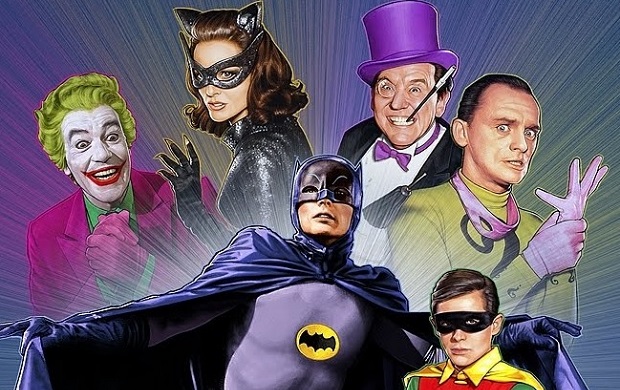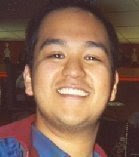
I recently found a picture of my very first birthday complete with a cake shaped just like Batman. The bright blue tights, the shiny yellow utility belt, and the charming grin could only have come from the 1966 television series starring Adam West. I vividly remember singing along with the infectious earworm of a theme song, punching and kicking the air imagining POW’s and BIFF’s flashing before me. It was a real treat when the weekend afternoon rolled around and reruns of this classic show would air. I was on the edge of my seat for every classic cliffhanger. But thankfully, I did not have to wait a whole day to find out what happened to the dynamic duo, even though it was a safe bet that they would escape relatively unscathed.
The history of the live-action Batman television show begins very much like an episode of the series itself, with William Dozier. Dozier is uncredited but it was his voice that narrated each exciting opening and harrowing cliffhanger with the booming timbre of a radio show host from the 1930s. But it would be his role as producer that would prove to be his legacy with the show. After reading a few comics (the first he had ever read), Dozier felt that the show would work best if it was done in the style of a campy comedy aimed at all ages with brightly colored sets that seemed to explode out of the pop art scene of the time. However, 20th Century Fox felt that the show would be much more successful if it were produced as a serious adventure show that was aimed at a younger audience. Two separate dynamic duos were screen tested and, in the end, Batman and Robin would forever be associated with Adam West and Burt Ward, respectively.
As any fan of any Batman would attest, what makes a great Batman story is a great villain and this series was no exception. Frank Gorshin would be the first of many accomplished character actors who would plot against the citizens Gotham as the Riddler (a role that John Astin played during Gorshin’s season two hiatus). Burgess Meredith was no stranger to the world of television, but he still gave an incomparable performance as Oswald “The Penguin” Cobblepot giving birth to a squawking laugh that is unmatched to this day. Versatile entertainer Cesar Romero also had an unforgettable laugh that, as legend has it, was his actual laugh that producers insisted he incorporate into the Clown Prince of Crime’s repertoire. Refusing to shave off his trademark mustache, make-up artists would paint over his facial hair giving him a unique and unforgettable look in addition to his unforgettable laugh. The femme fatale role of Catwoman was given to Julie Newmar, whose star was very quickly on the rise at the time she was cast.
Sometimes the show featured villains directly out of the comics such as The Archer played by Art Carney, Walter Slezak’s Clock King, and David Wayne as the Mad Hatter. Mr. Freeze was portrayed by three separate actors: George Sanders, Otto Preminger, and Eli Wallach. Eventually the Batman series would be the place to tune in as villains were created specifically for the show to accommodate the larger than life celebrities clamoring to be a part of the pop culture phenomenon. Some of the most memorable performances on the show were of villains created specifically for the big name actors who portrayed them like Victor Buono as King Tut, Vincent Price as an egg-cellent Egghead, Cliff Robertson as Shame, Joan Collins as Siren, Zsa Zsa Gabor as Minerva, Milton Berle as Louie the Lilac, and even Liberace made it to the show as the villainous Chandell and his not-so-villanous doppelganger, Harry.
The show was an instant success creating fan favorites out of otherwise unknown characters from the comics such as Alan Napier’s Alfred, Neil Hamilton’s Commissioner Gordon, and Madge Blake who played Dick Grayson’s Aunt Harriet. Chief O’Hara was played by Stafford Repp and created for the series but was later added to the comics. On July 30, 1966, Batman: The Movie was released and with a bigger budget, the creators of the show decided to go all out for the big screen debut. New gadgets such as the Batcopter, Batcycle, and Batboat were introduced into the caped crusader’s arsenal. And not only did this adventure have new equipment and a longer runtime, but the dynamic duo would have to save the day from four supervillains. The Joker, Penguin, and The Riddler along with Catwoman formed the United Underworld to hold the United World Organization’s Security Council hostage, threatening to turn them into dust with a dehydrator. Every actor reprised their role except Julie Newmar who was replaced with Lee Meriwether due to scheduling conflicts.
Opening to a lukewarm reception, the movie seemed to reflect the oncoming decline of the television series. Head script writer, Lorenzo Semple, Jr. had set the tone for the first season but was noticeably absent in the second. Julie Newmar’s rising fame tied up her schedule even further resulting in the purr-fect casting of Eartha Kitt as Catwoman. The ratings for the show had declined by the third season and in an attempt to boost viewership, the creators decided to debut a character straight out of the comics before she even officially debuted on the comics. Yvonne Craig was cast as Commissioner Gordon’s daughter, Barbara who was a librarian by day but by nightfall she was Batgirl. Her tenacity was a welcome breath of fresh air that still maintained the balance in the dynamic duo, which she turned into a thrilling trio. But even with the addition to this new character, it would not be enough to save the show from poor ratings and budget cuts and ABC cancelled the show before the end of season three. Even an attempt by NBC to save the show was thwarted when the sets were inadvertently destroyed.
There are those that would argue that the campy, comedic style of the 1960’s television series was a disaster whose popularity was a mere fluke of the psychedelic age. That a majority of its cast had their respective careers ruined by typecasting, unable to crawl out of their characters’ shadows. But I beg to differ. When the show was picked up, the comic was not selling at all,and Batman nearly went the way of his other serial contemporaries, forgotten by most. In fact, the television series bridged the gap between the would-be death throes of the comic and the prolific era of Dennis O’Neil and Neal Adams in the 1970’s. The cast has since reunited several times and both Adam West and Burt Ward have recently signed to voice the dynamic duo in an unnamed animated movie. The longevity of the caped crusader and the boy wonder would not be what it was without the colorful 1966 series, which continually introduce the characters to new generations. Will this popularity continue? I’m willing to find out by tuning in at the same bat- time, same bat-channel. Happy anniversary, Batman!

Excellent read! I watched the TV series a lot and can enjoy both serious and campy Batman
ReplyDelete